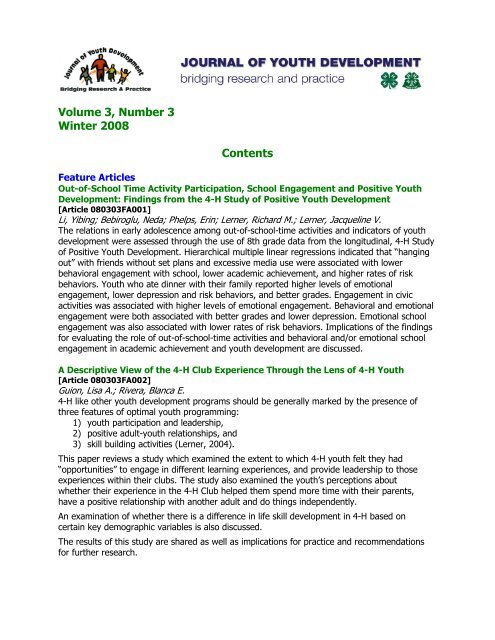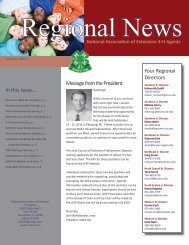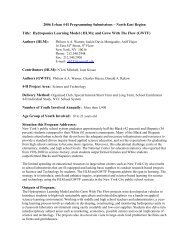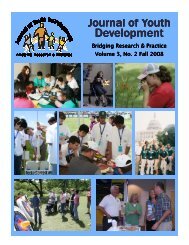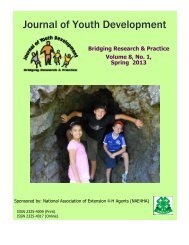Winter 2008 - Vol. 3 No. 3 - National Association of Extension 4-H ...
Winter 2008 - Vol. 3 No. 3 - National Association of Extension 4-H ...
Winter 2008 - Vol. 3 No. 3 - National Association of Extension 4-H ...
- No tags were found...
Create successful ePaper yourself
Turn your PDF publications into a flip-book with our unique Google optimized e-Paper software.
<strong>Vol</strong>ume 3, Number 3<strong>Winter</strong> <strong>2008</strong>ContentsFeature ArticlesOut-<strong>of</strong>-School Time Activity Participation, School Engagement and Positive YouthDevelopment: Findings from the 4-H Study <strong>of</strong> Positive Youth Development[Article 080303FA001]Li, Yibing; Bebiroglu, Neda; Phelps, Erin; Lerner, Richard M.; Lerner, Jacqueline V.The relations in early adolescence among out-<strong>of</strong>-school-time activities and indicators <strong>of</strong> youthdevelopment were assessed through the use <strong>of</strong> 8th grade data from the longitudinal, 4-H Study<strong>of</strong> Positive Youth Development. Hierarchical multiple linear regressions indicated that “hangingout” with friends without set plans and excessive media use were associated with lowerbehavioral engagement with school, lower academic achievement, and higher rates <strong>of</strong> riskbehaviors. Youth who ate dinner with their family reported higher levels <strong>of</strong> emotionalengagement, lower depression and risk behaviors, and better grades. Engagement in civicactivities was associated with higher levels <strong>of</strong> emotional engagement. Behavioral and emotionalengagement were both associated with better grades and lower depression. Emotional schoolengagement was also associated with lower rates <strong>of</strong> risk behaviors. Implications <strong>of</strong> the findingsfor evaluating the role <strong>of</strong> out-<strong>of</strong>-school-time activities and behavioral and/or emotional schoolengagement in academic achievement and youth development are discussed.A Descriptive View <strong>of</strong> the 4-H Club Experience Through the Lens <strong>of</strong> 4-H Youth[Article 080303FA002]Guion, Lisa A.; Rivera, Blanca E.4-H like other youth development programs should be generally marked by the presence <strong>of</strong>three features <strong>of</strong> optimal youth programming:1) youth participation and leadership,2) positive adult-youth relationships, and3) skill building activities (Lerner, 2004).This paper reviews a study which examined the extent to which 4-H youth felt they had“opportunities” to engage in different learning experiences, and provide leadership to thoseexperiences within their clubs. The study also examined the youth’s perceptions aboutwhether their experience in the 4-H Club helped them spend more time with their parents,have a positive relationship with another adult and do things independently.An examination <strong>of</strong> whether there is a difference in life skill development in 4-H based oncertain key demographic variables is also discussed.The results <strong>of</strong> this study are shared as well as implications for practice and recommendationsfor further research.


